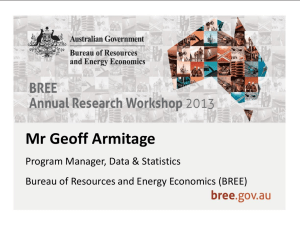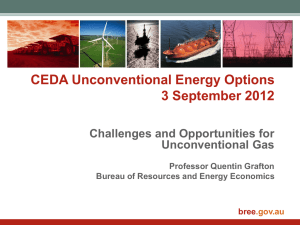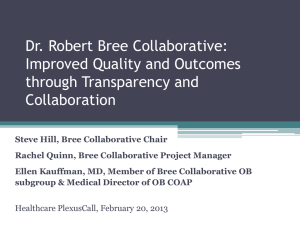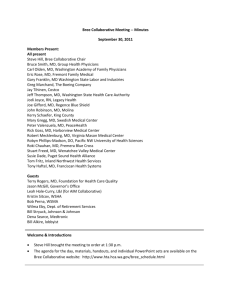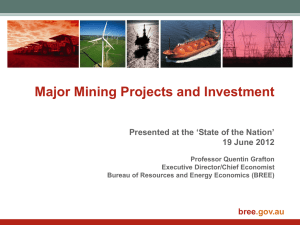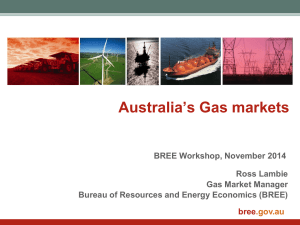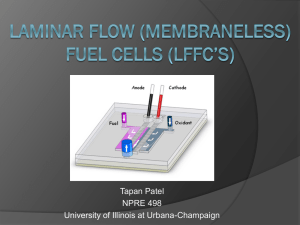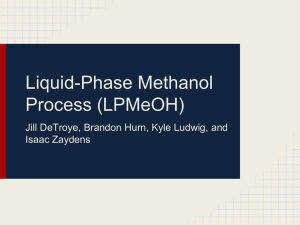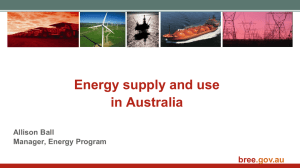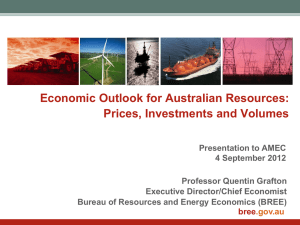PPT 5.4MB - Department of Industry
advertisement
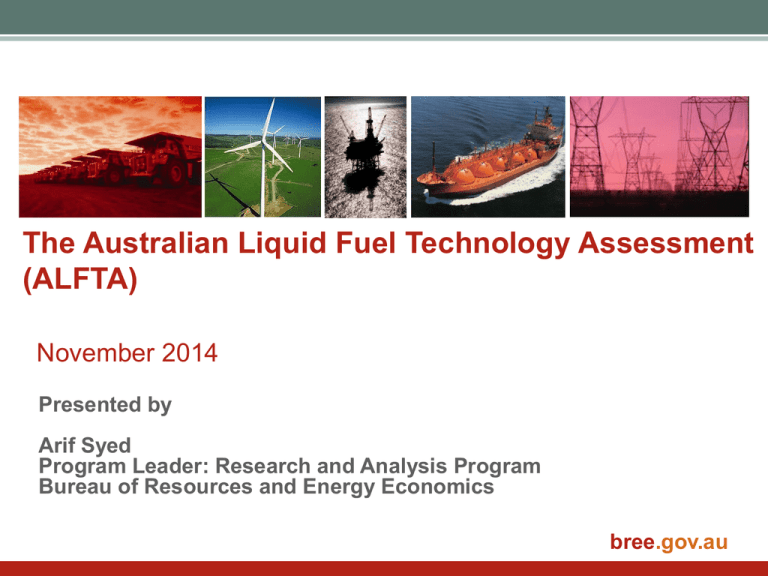
The Australian Liquid Fuel Technology Assessment (ALFTA) November 2014 Presented by Arif Syed Program Leader: Research and Analysis Program Bureau of Resources and Energy Economics bree.gov.au Outline I ALFTA Overview II Assumptions, Costs and Technologies III ALFTA Model IV Levelised Costs of Fuel Over Time V Key Findings bree.gov.au I. ALFTA Overview: Previous Work • International studies are not easily available on the cost of liquid fuel technologies (for transport use). • In 2012-13, the Department of Resources, Energy and Tourism engaged the LEK consultancy to produce cost estimates of advanced biofuel production technologies. • The study essentially remained inconclusive in producing the levelised cost of fuel estimates (production cost of liquid fuels for transport uses). bree.gov.au Aim of ALFTA • ALFTA provides the best available and most upto-date estimate of current and future costs (component cost and levelised costs) of 18 liquid fuel technologies for transport use. bree.gov.au Approach • Component costs have been developed through a bottom-up engineering analysis of each of the technologies. These costs include, costs such as domestic capital costs, international capital costs, labour productivity, etc. • Parameters provided for each fuel generation technology (thermal efficiency, O&M costs, fuel costs, capacity factors, etc. bree.gov.au ALFTA Report and Model (1) ALFTA Report: Details the technologies and methods. (2) ALFTA Model: Available upon request: www.info@bree.gov.au bree.gov.au II. Key Assumptions • Key assumptions include: (1) economic growth of 2.5%; (2) AUD moving to 0.86 USD/AUD by 2031-32. • Capital costs are provided on the basis of an Nth-of-a-kind (NOAK) plant in Australia and at a utility-scale. bree.gov.au Component Costs • Capital Costs (local & international components) • Operation & Maintenance (fixed and variable) • Feedstock-input costs (provided by ACIL Allen) • Owner’s costs bree.gov.au 18 Fuel technologies covered: 1. Conventional petroleum fuels 2. Liquid petroleum gas 3. Compressed natural gas 4. Liquefied natural gas 5. Gas to liquids 6. Coal to liquids 7. Biomass to methanol 8. Solar dissociation 9. Conventional bioethanol 10. Advanced lignocellulose bioethanol 11. Advanced bioethanol - synthesis gas fermentation 12. Biodiesel by transesterification 13. Hydrothermal upgrade 14. HEFA/HVO 15. Algal biomass via HEFA/HVO 16. Methanol/DME/MTG 17. Fast pyrolysis 18. Alcohol to jet bree.gov.au Levelised Cost of Fuel (LCOF) LCOF=KC + O&M fix + O&M var + FC + SC + PC Where, the LCOF =$/GJ bree.gov.au III. ALFTA Model • Values of more than 17 cost parameters can be altered by users to explore the LCOF estimates’ sensitivity to the user’s input. bree.gov.au ALFTA Regional Costs F. Coal to Liquids Regional Capital Biomass to Methanol Cost Modifiers 100.00% 105.00% 105.00% 120.00% East Coast East Coast West Coast West Coast Metropolitan Regional Regional 100.00% 105.00% Metropolitan 105.00% 120.00% bree.gov.au LCOF breakdown in cost components Select Technology: M. Advanced Bioethanol - Synthesis Gas Fermentation Select Region:East Coast Regional LCOF Component ($/GJ) 2013 2020 2025 2030 2040 2050 Capital Cost #N/A 25 23 21 18 16 Fixed O&M #N/A 5 5 5 6 6 Variable O&M #N/A 8 8 9 10 11 Feedstock Costs #N/A 13 13 13 13 13 Cost of Emissions #N/A 0 0 0 0 0 TOTAL LCOF #N/A 52 50 48 47 46 bree.gov.au IV. LCOF over time M. Advanced Bioethanol Synthesis Gas Fermentation 60 50 LCOF ($/GJ) 40 30 20 10 0 2010 2015 2020 2025 2030 Year 2035 2040 2045 2050 2055 East Coast Regional bree.gov.au HEFA / HVO LCOF comparisons 2013, real 2012-13 A$/GJ Biodiesel by transesterification Methanol to Gasoline Conventional Ethanol Compressed Natural Gas Conventional Petroleum Fuels Methanol to Dimethyl Ether Gas to Liquids Liquid Petroleum Gas Coal to Liquids Liquified Natural Gas 0 15 30 45 60 bree.gov.au Solar Fuel - Methanol - MTG LCOF 2020, real 2012-13 A$/GJ Solar Fuel - Methanol - DME Algal Biomass plus HVO HEFA / HVO Biodiesel by transesterification Synthesis Gas Fermentation Methanol to Gasoline Conventional Petroleum Fuels Conventional Ethanol Compressed Natural Gas Methanol to Dimethyl Ether Liquid Petroleum Gas Advanced Lignocellulosic Bioethanol Hydrothermal + Hydrogenation of bio oil Gas to Liquids Biomass - Methanol - MTG Fast Pyrolysis Biomass to Gasoline and Diesel Biomass - Methanol - DME Coal to Liquids Liquified Natural Gas $/GJ 0 45 90 135 180 bree.gov.au Solar Fuel - Methanol - MTG LCOF 2050, real 2012-13 A$/GJ Algal Biomass plus HVO Solar Fuel - Methanol - DME HEFA / HVO Biodiesel by transesterification Synthesis Gas Fermentation Conventional Petroleum Fuels Compressed Natural Gas Methanol to Gasoline Liquid Petroleum Gas Gas to Liquids Conventional Ethanol Methanol to Dimethyl Ether Hydrothermal + Hydrogenation of bio oil Advanced Lignocellulosic Bioethanol Biomass - Methanol - MTG Fast Pyrolysis Biomass to Gasoline and Diesel Liquified Natural Gas Biomass - Methanol - DME Coal to Liquids $/GJ -20 30 80 130 180 bree.gov.au V. Key Findings • There are several currently available technologies from which fuel production is already competitive with conventional petroleum fuels, i.e. have a lower LCOF. • By 2020, multiple emerging technologies are expected to be available at a lower LCOF than petroleum fuels. -- eg. Coal to Liquids (CTL) and Gas to Liquids (GTL). bree.gov.au Key Findings cont. • Advanced bioethanol fuel technologies become cost competitive in 2020, and remain cost competitive out to 2050. bree.gov.au Thanks arif.syed@industry.gov.au Thank you bree.gov.au bree.gov.au
